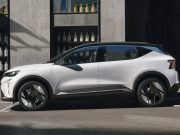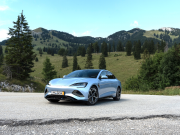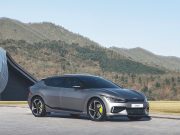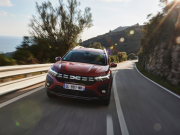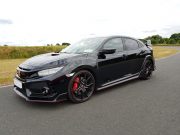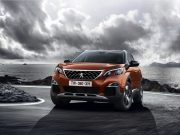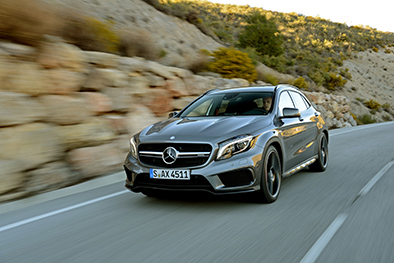 Honda has announced that the all-new HR-V, which is set to go on sale across Europe from late 2021, will solely be equipped with the company’s advanced e:HEV hybrid powertrain. By introducing the proven powertrain to the compact SUV, a new blend of efficiency and performance has been introduced to this highly competitive class.
Honda has announced that the all-new HR-V, which is set to go on sale across Europe from late 2021, will solely be equipped with the company’s advanced e:HEV hybrid powertrain. By introducing the proven powertrain to the compact SUV, a new blend of efficiency and performance has been introduced to this highly competitive class.
The next-generation HR-V’s e:HEV powertrain produces a total power output of 96kW (131PS), coupled with 253Nm of torque. The effect is an effortless and comfortable journey, whether travelling through urban areas or cruising at high speed on motorways. Its fuel-efficient hybrid system produces CO2 emissions from 122 g/km (WLTP) and fuel economy of 52.3mpg (WLTP), while also accelerating the HR-V from standstill to 62 mph in 10.6 seconds.
The all-new HR-V is the latest model to join the e:HEV family, joining the CR-V and Jazz in being available only with a hybrid powertrain. With no need to plug-in and charge, the HR-V is suitable for every driving situation, combining the responsive performance and efficiency of an electric vehicle with the usability and flexibility of traditional petrol and diesel powered cars.
e:HEV: low emissions, responsive performance
The advanced e:HEV hybrid powertrain offers a unique full hybrid experience, winning acclaim across Europe for combining strong performance with high levels of real-world efficiency and refinement. The system consists of two compact, powerful electric motors that work alongside an Atkinson-cycle 1.5-litre DOHC i-VTEC petrol engine, a lithium-ion battery and an innovative fixed-gear transmission coupled to an intelligent power control unit.
The e:HEV powertrain is already proven to produce a class-best ratio of fuel economy to acceleration in the new Jazz. Its application in the HR-V utilizes a similar arrangement for equally impressive efficiency, as revisions to the internal-combustion and IPU have resulted in an increase in torque. The number of battery cells has also been revised, increasing from 48 to 60 to account for the HR-V’s larger size, and to allow greater storage and deployment of electric power over the 80kW Jazz. Despite this larger battery cell size, interior space has not been compromised thanks to clever engineering of the battery pack. Further revisions to the powertrain include a reduction in the gear ratio between the electric motor and wheels, to cumulatively improve acceleration and the HR-V’s dynamic performance.
What sets the e:HEV system apart is how its three drive modes seamlessly interchange to ensure optimum performance of each component in both urban and motorway driving. The intelligent Electronic Control Unit automatically, and constantly, cycles between Electric Drive, Hybrid Drive or Engine Drive depending on which is the most fuel-efficient drive mode at that specific driving situation.
When driving at a constant high-speed, such as on the highway, the system operates on engine drive as that is the most efficient for that scenario. If further acceleration is required, such as when overtaking, the car will switch to hybrid drive for that additional performance boost. Additionally, when in Hybrid Drive, power from the petrol engine-driven generator can be diverted to recharge the battery, offering additional efficiency benefits.
‘Sport’ mode can be activated via the drive selector, enabling even sharper throttle response, whilst ‘Econ’ mode adjusts the air conditioning system and throttle response for an emphasis on fuel efficiency. In addition to ‘Normal’ mode, where the car is best balanced between both worlds, drivers can switch across all driving modes at the toggle of a switch.
For an increased EV-like experience, drivers can also select B-range from the transmission, which offers selectable levels of energy recovery when coasting or braking. The level of energy recovery and the resulting strength of the deceleration effect can be substantially increased over the regular D-range, by using the paddles behind the steering wheel.
The transfer between these drive modes – including the start of the engine to generate electric power – is virtually unnoticeable to the occupants. Rather than using a conventional power split system with a planetary gearbox which causes high levels of friction, the fixed gear transmission creates much less resistance through minimised gearing, ultimately consuming less energy when driving purely electric. Due to this, Honda’s highly efficient system achieves a higher ratio of accumulated electric drive time when driving in cities than other hybrids on sale today.
Applying Formula 1 hybrid expertise
Using engineering expertise from its motorsport team, Honda’s race-winning Formula 1 Hybrid Power Unit programme has inspired the technology in the e:HEV hybrid system to deliver unrivalled levels of energy efficiency on the road. As a result, the new e:HEV HR-V offers exceptional efficiency and power output in a wide range of driving conditions.
Hybrid heritage
The original 1999 Honda Insight established Honda as a world leader in hybrid technology. The first hybrid model from any manufacturer to be sold in Europe, it introduced the brand’s Integrated Motor Assist (IMA) system, which relied mainly on the engine and called upon electric motor assistance and brake energy recuperation when required to enhance acceleration and reduce fuel consumption. Honda has continued to develop its hybrid technology, and the advanced two-motor e:HEV system is now used in the Jazz, CR-V, all-new HR-V and upcoming 11th-generation Civic.
The all-new HR-V e:HEV will be available in Europe from late 2021.













